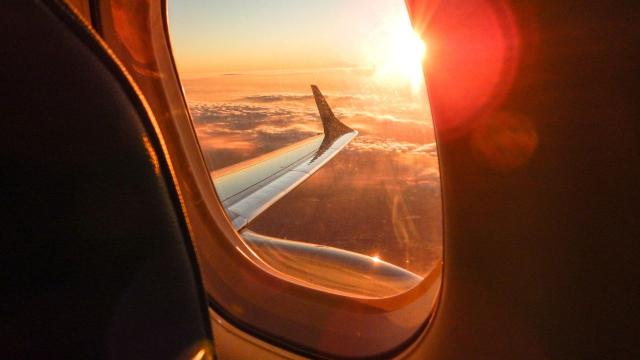In addition to the beeps and chimes that you hear on an airplane, you may also pick up on a variety of mechanical sounds before and during a flight, as well as after you’ve landed. Unless you have aviation experience or knowledge (or are travelling with someone who does), you may be curious—or anxious—about what’s causing these noises, and what they mean. Here are a few examples.
High-pitched squealing, scrubbing, or barking dogs
If you’re traveling on an Airbus aircraft and hear what sounds like a back-and-forth scrubbing sound, or barking dogs in the cargo hold, you’re probably hearing the hydraulic system(s) (there are typically three) being powered up, says Jack Herstam, an airline pilot and former flight instructor. On other types of aircraft, it may sound more like a high-pitched squealing noise, he adds.
“The sounds you hear are the hydraulic accumulators charging the reservoirs to the required pressure to operate brakes, steering, reverse thrust, and control surface movements,” Herstam explains. You’re most likely to hear these hydraulic noises after the airbridge has been removed, and the airport employees on the ground are safely out of the way.
Humming of varying intensity
The dull humming in the background is the sound of the airplane’s engines. If you’ve been aware of this sound, then you probably also noticed the shifts in noise level throughout a flight: Getting softer when less engine power is needed (e.g. while descending) and getting louder when the plane requires additional power (e.g. when turning).
And if the hum of the engines makes you sleepy, you’re not alone. The sound is an example of brown noise, which some people seek out to lull them to sleep—or, in other cases, to help them focus. Here’s how Dan Berlau, professor of pharmaceutical sciences at Regis University explains it:
Like white noise, brown noise contains all frequencies that the human ear can hear. The difference is that brown noise turns up the lower frequencies and softens the higher frequencies.
White noise in the background
The air circulating through the airplane’s cabin adds another layer to the background sound. Most of the time, you’ll hear this higher-frequency white noise as soon as you step on board, says Herstam, adding that it could vary in intensity before, during, and after the flight.
For the most part, it’s the sound of air conditioning, courtesy of the auxiliary power unit (APU). The APU provides power to the aircraft when the engines aren’t on, and it’s not connected to ground power, Herstam explains. The sound tends to be the loudest in the back of the plane.
If the sound is weak before takeoff, the plane is probably connected to pre-conditioned air (PCA), which comes from that big yellow tube that connects to the underside of aircraft, Herstam notes. At this point, you’re not going to get much airflow out of the nozzle above your seat, but it’ll get stronger once the APU is turned on.
Lastly, if you don’t hear that distinctive air sound at all either when you board the plane, or it pulls up to the gate after landing, Herstam says that means the APU is off, and the PCU is not connected. This will make the plane unusually quiet (and probably stuffy), because no air is circulating in the cabin.
Medium-pitched hydraulic sound
Everyone’s on board: The aircraft doors have closed, the engines started, and the plane pushes back from the gate. Prior to taxiing, you hear 10 to 20 seconds of a hydraulic-sounding medium-pitched noise.
If you’re in a window seat with a view of the wings, you may notice the slats (on the front of the wing) and flaps (on the back)—the cause of this noise—move when you can hear it, Herstam says. You’ll also probably hear this sound as the plane gains altitude and the flaps and slats are retracted, and then again when approaching the destination.
Banging noises
The banging you hear after boarding and before the plane leaves the gate is most likely the sound of baggage being loaded into the cargo hold. If you’ve ever watched this process, then you know that the luggage is often tossed around (not necessarily gently), which could contribute to the banging noise. When you hear an especially loud bang, followed by a thud, that’s the cargo door being closed. Flights typically end with a bang, too: This time, it’s the landing gear doors opening, and the wheels being deployed.
Lead Image Credit: iStock

Leave a Reply
You must be logged in to post a comment.